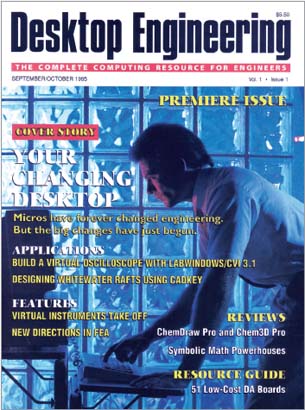Latest News
December 1, 2010
 |
The way you found out what was going on in the design for manufacturing world was a different animal in 1995, and Desktop Engineering played a key role in the changes we now take for granted. Here’s how DE got going and what affect it had.
I hired Ann Grummon, Desktop Engineering’s first editor, as the premier issue—September 1995—went to press. I tossed some article printouts at her and told her to find typos. She dug right in, likely because I was cranky. Everything had to be just so, and the outfit I worked for cherished antique ideas about publishing. I derided them as “country club publishing.” We battled. I won. Still, secretly, I fretted that, once again, I had shot off my mouth and got in way over my head. No one had seen an engineering trade magazine like DE before. But, wait. I’m getting ahead of myself.
Helmers Publishing—later Level 5 Communications—hired me in the summer of ’94. Writing about computer stuff had been my gig since ’79. I had logged in more than a dozen years at BYTE magazine, worked for an InfoWorld publication, and done freelance. Throughout the ’80s, I was a key player developing BIX, BYTE’s ill-fated online content offering—the first by a major publisher. BIX. Sheesh. One of the execs who sold it off commented to me as he showed me the door that “no one will ever be interested in the Internet.” That was ’92. He got the big bucks for such foresight.
 DE’s first cover in September, 1995. |
Defining Desktop Engineering
Anyway, Helmers hires me. Tells me that I’ll soon run the editorial of a new publication for design and mechanical engineers and get the company’s publications online. Now, just what this new rag was about was a mystery. One owner clung like a tick to the idea of computer algebra software; the other found nirvana in field computers. So, they sat me in a corner rewriting stuff on sensing technologies—accelerometers, LDVs, the whole shebang—for one of their existing pubs as they puzzled their data out.
Laura Hanson was the sorter. She researched the audience and advertising markets for the owners’ ideas. Laura’s data was excellent. Only, it showed that there wasn’t advertising or audience interest in either of the owners’ ideas.
What to Do?
So, it’s January ’95. I get called into a YAM (yet another meeting) with the owners, the CEO, and Laura. Our agenda: “What to do?”
Laura’s research had revealed something interesting about the reading habits of engineers back then: You read the trade magazines of the day to learn about engineering. These were black, white, and stunningly dull. Reading them, you would have thought engineering went hand-in-hand with undertaking. But you also read flashy, full-color magazines like BYTE or MacUser to keep up on computing technology. (A lot of you read Playboy too, by the way.)
We dug a little. You weren’t reading PC World for the centerfold. You hoped to find a tiny ad and an occasional article on engineering stuff.
On your desk, you had a 386- or 486-based PC on your desktop for “business” work. For engineering you had a dumb terminal connected to a mainframe somewhere and all sorts of black boxes scattered around. You hated the terminal and loved your PC. About a third of you, if memory holds, were online at work, with all the rest expecting to be so soon.
Engineering is Sexy
So, I’m in this YAM and I, devoid of a gatekeeper to censor whatever pops into my head, looked at this data and ralphed out some ideas in rapid, generally profane succession. Disclaimer: I had done some blue-sky dreaming with this guy John Hayes, my boss. So, I am not claiming total genius, but I am claiming that I was jumping up and down spouting off about what I wanted to do.
- We’ll do an engineering trade magazine that’s as sexy looking as a newsstand magazine. This is the MTV generation, I argued. Give them media that looks like what they expect out of media, not 1960s reruns.
- We’re about PC-based engineering software and hardware. This was engineering word-weenieship heresy in ’95. Everybody believed that engineering software meant “big iron” and that micros meant Windows. Windows and engineering? Double heresy.
- Marry no technology, not even Windows. Technologies come and go like bad hairdos. But the world will forever turn to engineers to solve its big problems.
- This was the tricky one: We’ll look at engineering computing from the design and mechanical engineer’s point of view. We’d inform you about the newest technologies, tell you what’s in it for you, and show how these technologies help you solve problems.
- Engineering is fun. One shall eschew ponderous third-person prose. Making things work, designing new things, having your work blow up a few times before it works is fun. Engineers are our people and passion. Let’s entertain as we inform.
OK, now, Helmers did technology—think sensors and bar code readers. Grok robotics, not people. Dull gray, albeit informative, narrative suffused its DNA, so much so that one of its publications had a policy of no verbs in article titles. “One finds it too jarring” in the words of one long-time editor.
My diatribe elicited silence and blank stares from the owners. Yet, after an endless minute, we got the go ahead. “We” was John Hayes as publisher, Dan Harper as sales guy, Lee Ann Modestino as office manager/ad coordinator, and me as editor in chief of a staff of me. We shared Robin Haubrich in the graphics art department with the other businesses in-house.
We needed a name for this thing. Again, Laura’s research came in handy. We identified Cadence, CADalyst, CAE, and Personal Engineering & Information News (PE&IN) as kind-of competitors. Only CADalyst survives today in a different form. We looked at these outfits and noticed one thing: They had little interest in the desktop computer. Oh, I can hear people I know who worked for them objecting. With the exception of PE&IN, they paid desktop computing lip service, unless it had something to do with Autodesk or National Instruments. The big money was in big iron.
So, we invested in the little guy who was betting that microcomputers were going to be the next big thing. This naturally led us to the “desktop” part of the title. Who blurted it out first, I do not know. I’ll leave it you to figure out the “engineering” part.
Issue One
OK, now I had to make the editorial pudding set. I got an article on computer algebra systems (not that much of a dummy, eh?) for PCs that later grabbed worldwide attention. Another article reviewed programming PC-based data acquisition boards with LabVIEW from National Instruments, and a fun one covered using MCAD software to design whitewater rafts. FEA with 100k elements on a PC was a show-me piece that broadcast our intentions to cover the changing world of analysis. And I pieced together the thoughts of industry leaders for the cover story “Your Changing Desktop.” That article’s subtitle said it all: “Micros have forever changed engineering. But the big changes have just begun.”
So, anyway, Grummon, as well as Brian Vaillancourt, later to become DE’s publisher, arrives right as I was finishing that first issue. Then we let our baby go out there to you, dear Desktop Engineering reader, and waited to see if we’d have a job come 1996. (Ever hopeful—or scared, depending on your point of view—we began building a website that went live soon after our first issue hit your snail mail address.)
Looking back over 15 years of this extraordinary resource for engineers, it’s plain to see that our instincts were right then as they are now. News and information about products and technologies that you need never needed to be boring, as it was before Desktop Engineering. That’s one reason why you now have a choice of exciting online information sources, some really lousy blogs as well as some good ones, and some truly good hard and digital copy.
We made our mistakes over the years, of course. Mine are legion. Still, in 1995, I believe Desktop Engineering changed the world of engineering trade magazines and how you get information forever. And knowing what little I do about DE’s future plans, you haven’t seen anything yet.
Thanks, pal. — Lockwood
Subscribe to our FREE magazine, FREE email newsletters or both!
Latest News
About the Author
Anthony J. Lockwood is Digital Engineering’s founding editor. He is now retired. Contact him via [email protected].
Follow DE





